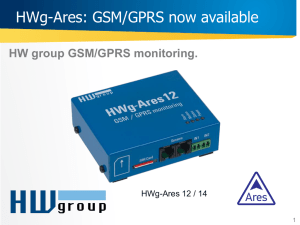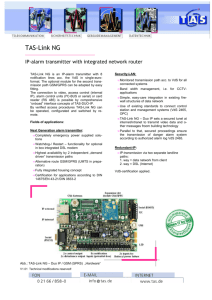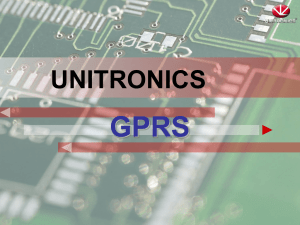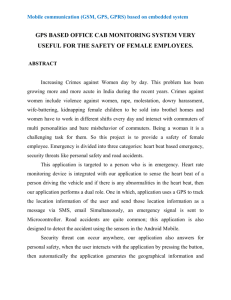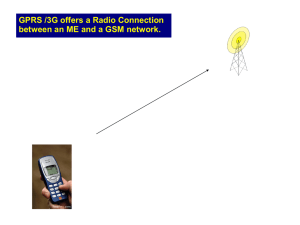Chapter 4-Mobile Environment (Part 2)
advertisement
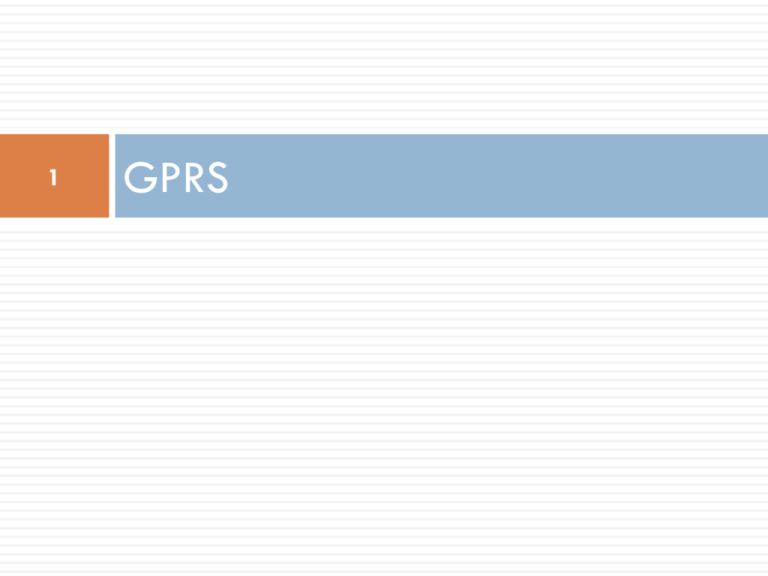
1 GPRS Before GPRS: HSCSD 2 HSCSD or High Speed Circuit Switched Data was the first upgrade to be standardized by ETSI to bring high speed data to GSM The standardization process started as early as 1994 and therefore, HSCSD was the first high speed data extension to be ready for implementation in 1999 Channel coding to increase the data rate from 9.6 kbps to 14.4 kbps Up to 4 time slots combined per user. HSCSD is able to reach throughput rates of up to 57.6 kbps HSCSD Network Infrastructure 3 HSCSD is a circuit-switched technology One of its major advantages is that the existing core network, mainly the MSC is able to handle HSCSD traffic. As opposed to GPRS, HSCSD neither requires hardware upgrade within the network, nor does it introduces new channel coding methodologies. HSCSD is a rather simple upgrade of the standard GSM, particularly in comparison with GPRS and EDGE. GPRS 4 GPRS is a packet switched transmission Provides the transmission of data in packet form Switches data at packet level Can always be online and users can be charged based on the amount of transmitted data rather than network time. The radio and network resources are only accessed when data actually needs to be transmitted between the mobile user and the network In between alternating transmissions, no network resources need to be allocated GPRS 5 In circuit-switched transaction where resources are being accessed permanently, regardless of whether or not transmission is actually taking place GPRS 6 Therefore, packet-switching saves resources, especially in the case of bursty transactions GPRS 7 Packet overlay over existing GSM digital circuit switched network Using packet-switching and is more suitable for bursty traffic “Always on” / “Always connected” TCP/IP based (Allows data packets to be conveyed across network using packet switching After initial log-on, user is permanently connected to IP services Bandwidth on demand Network resources only used when data is ready to be transmitted More efficient utilization of air time Performance 8 GPRS offers bandwidths up to 160 kbit/s GPRS applies timeslot bundling and new channel coding schemes have been defined, compared to GSM With 8 timeslots and coding scheme 4, GPRS is able to provide a net throughput rate of 160 kbit/s The channel coding schemes that provide for higher data transmission rates per slot sacrifices data protection for speed. Performance 9 The new coding schemes CS-2, CS-3 and CS-4 make less provision for forward error correction and can only be applied when radio conditions are good to excellent 1 timeslot 2 timeslots 8 timeslots CS-1 8.0 kbit/s 16.0 kbit/s 64.0 kbit/s CS-2 12.0 kbit/s 24.0 kbit/s 96.0 kbit/s CS-3 14.4 kbit/s 28.8 kbit/s 115.2 kbit/s CS-4 20.0 kbit/s 40.0 kbit/s 160.0 kbit/s GPRS/GSM network architecture 10 Network architecture 11 For GPRS, the existing network switching infrastructure cannot be reused. An entirely new core network architecture is required. The base station subsystem or BSS can be used for both circuit-switched and GPRS packet-switched services. BSS needs to be upgraded with the so-called Packet Control Unit or PCU The new network elements within the GPRS core network are the serving GPRS node (SGSN) and the Gateway GPRS Support Node (GGSN) GPRS, compared to GSM 12 GPRS GSM 2.5 G 2G Packet switched network Circuit switched network Higher transmission rate – 160kb/s Transmission rate only 9.6 kb/s Allow direct connection to internet No direct connection to internet Charging per data volume Charging per amount of time connection GPRS architecture differ from GSM 13 Different Mobile Station New mobile station is needed for accessing GPRS services. Backward compatible for voice calls Base Transceiver Station Software upgrade is needed in the existing BTS Base Station Controller Software upgrade and new hardware, needed packet control unit GPRS support nodes Installation of new core network elements – GPRS support node, gateway GPRS node Databases Requires software upgrade to handle new models and functions to handle databases involved in the network EDGE 14 Formerly, EDGE was the abbreviation for Enhanced Data Rates for GSM Evolution With EDGE being adopted by the North American market, EDGE is the acronym for Enhanced Data Rate for Global Evolution EDGE introduces a new modulation scheme which is an 8-PSK in addition to GMSK in the case of GSM GPRS and HSCSD works with the normal GSM modulation scheme which is GMSK. GMSK has lots of advantages, the most important of which being that it does not contain any amplitude modulation. Its low speed is one disadvantage. In GMSK, only 1 bit can be transmitted per symbol, as opposed to 8-PSK where 3 bits are transmitted per symbol This makes 8-PSK three times faster than GMSK EDGE requires a major hardware upgrade 15 EDGE is mainly concerned with the modulation scheme on the Air-interface. Adding 8-PSK as a new modulation scheme requires all base stations to receive hardware upgrades of their RF-parts to support the EDGE technology. This is a major undertaking which is risky, and most importantly, costly to the operator. EDGE (cont...) 16 Require h/w and s/w upgrade of both BS and MS Used 8-PSK in addition to GMSK Uses 9 air interface formats, known a multiple Modulation and Coding Schemes (MCS) autonomously and rapidly selectable for each time slot or user. Controlled by a feedback loop for maximum throughput with an acceptable outage performance Using all 8 slots, can reach a max of 547 Kbps per user, practically 384Kbps per user per carrier.

